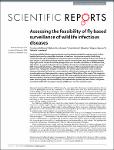Assessing the feasibility of fly based surveillance of wildlife infectious diseases
Hoffmann, Constanze
Stockhausen, Melanie
Merkel, Kevin
Calvignac-Spencer, Sébastien
Leendertz, Fabian H.
Monitoring wildlife infectious agents requires acquiring samples suitable for analyses, which is often logistically demanding. A possible alternative to invasive or non-invasive sampling of wild-living vertebrates is the use of vertebrate material contained in invertebrates feeding on them, their feces, or their remains. Carrion flies have been shown to contain vertebrate DNA; here we investigate whether they might also be suitable for wildlife pathogen detection. We collected 498 flies in Taï National Park, Côte d’Ivoire, a tropical rainforest and examined them for adenoviruses (family Adenoviridae), whose DNA is frequently shed in feces of local mammals. Adenoviral DNA was detected in 6/142 mammal-positive flies. Phylogenetic analyses revealed that five of these sequences were closely related to sequences obtained from local non-human primates, while the sixth sequence was closely related to a murine adenovirus. Next-generation sequencing-based DNA-profiling of the meals of the respective flies identified putative hosts that were a good fit to those suggested by adenoviral sequence affinities. We conclude that, while characterizing the genetic diversity of wildlife infectious agents through fly-based monitoring may not be cost-efficient, this method could probably be used to detect the genetic material of wildlife infectious agents causing wildlife mass mortality in pristine areas.
No license information

